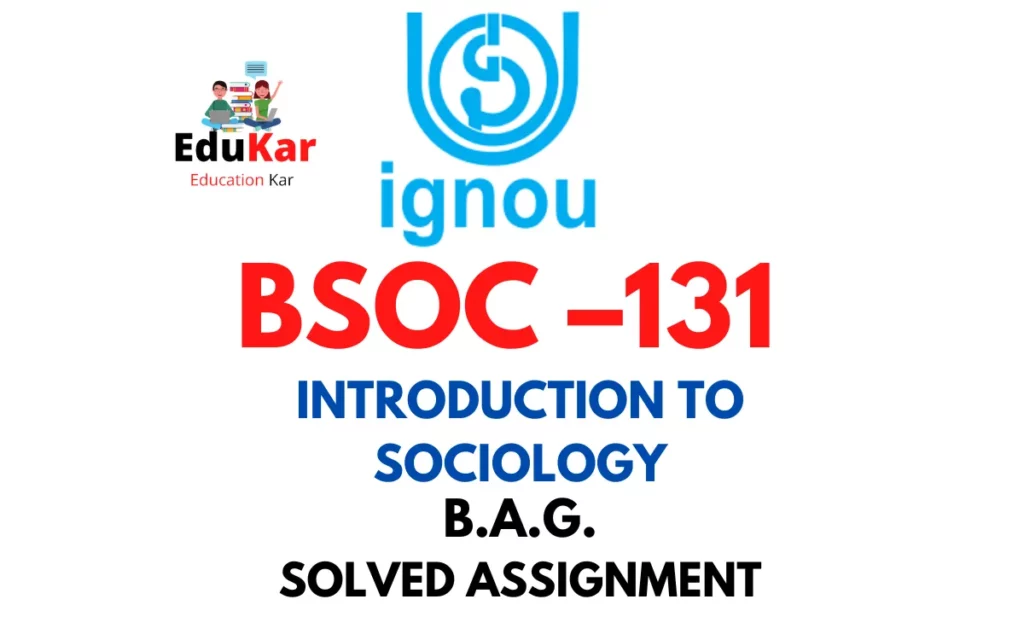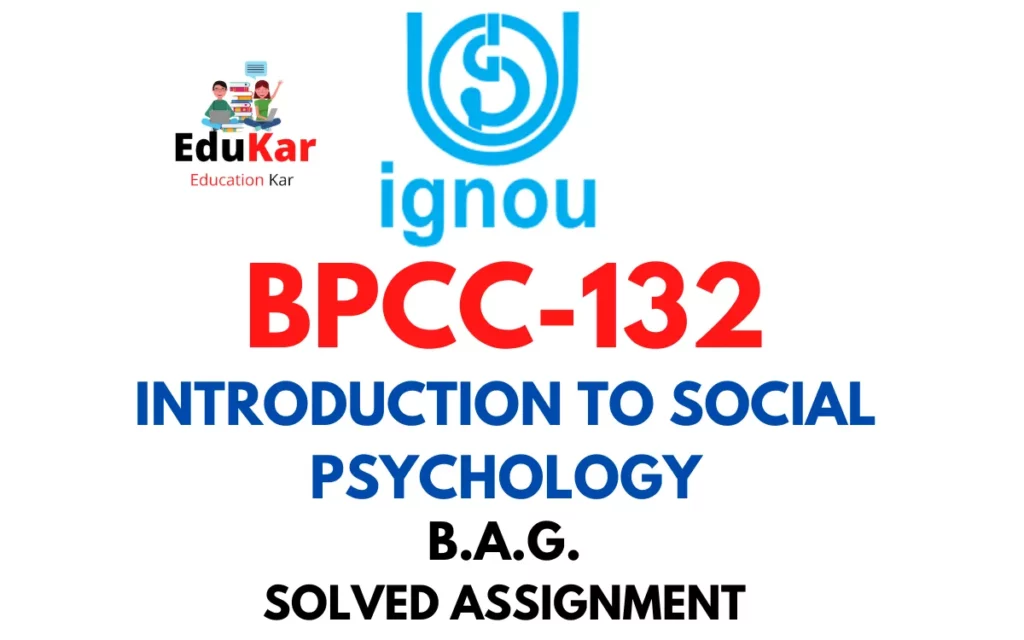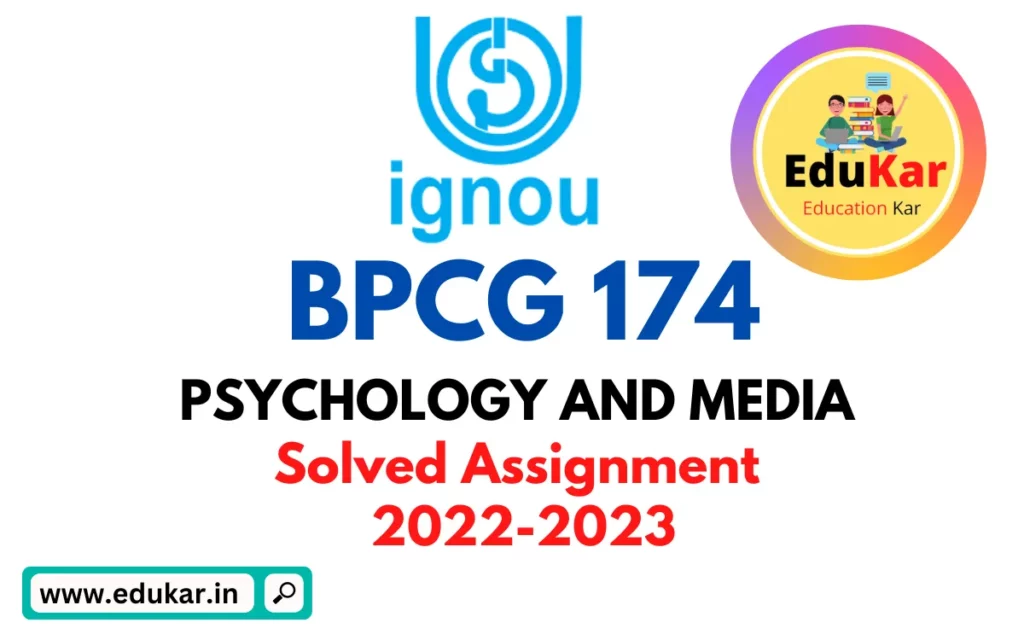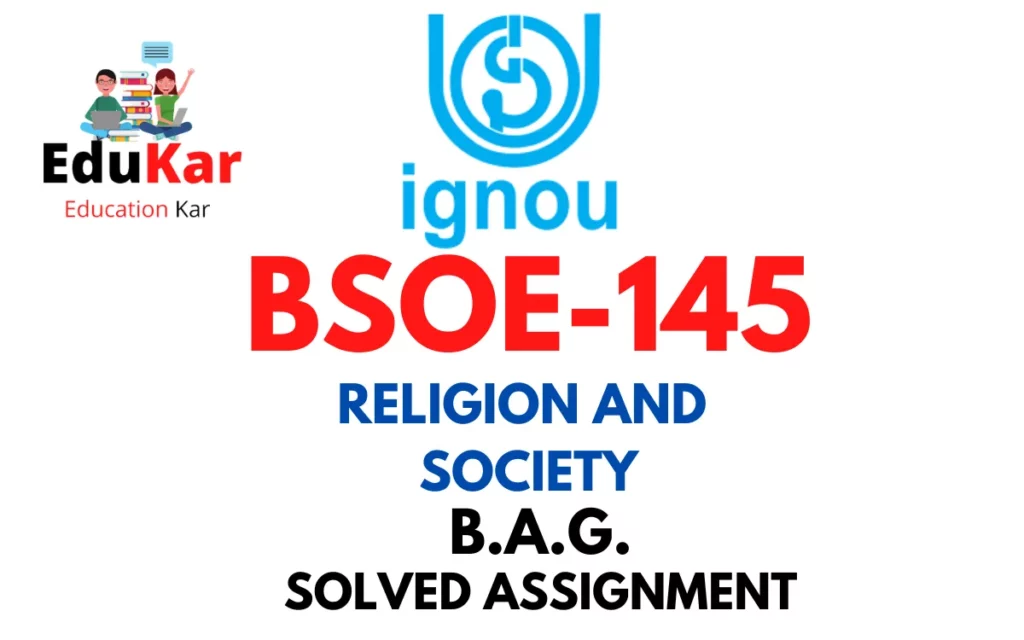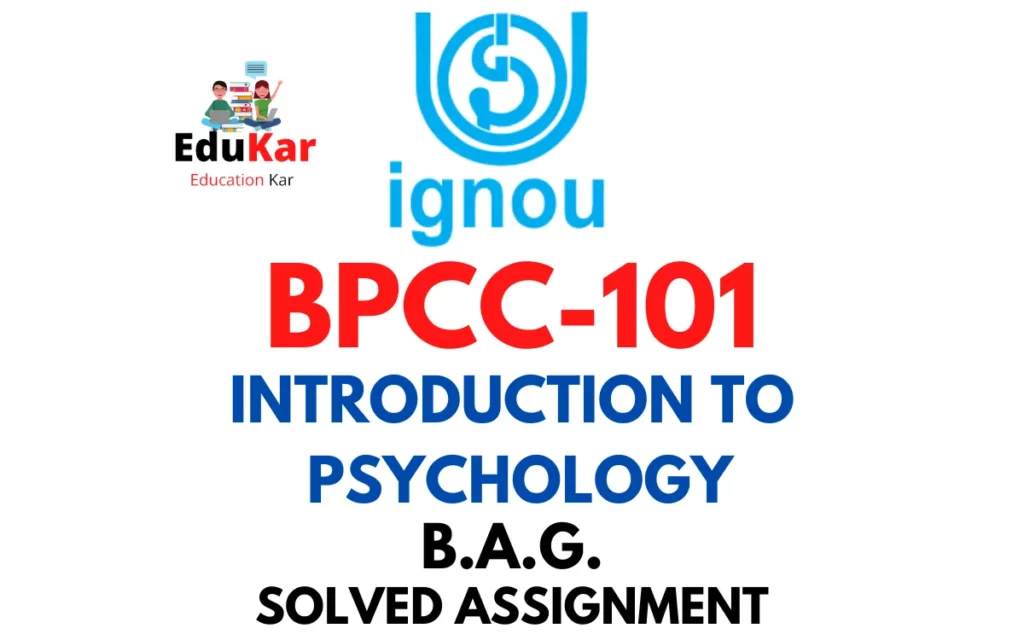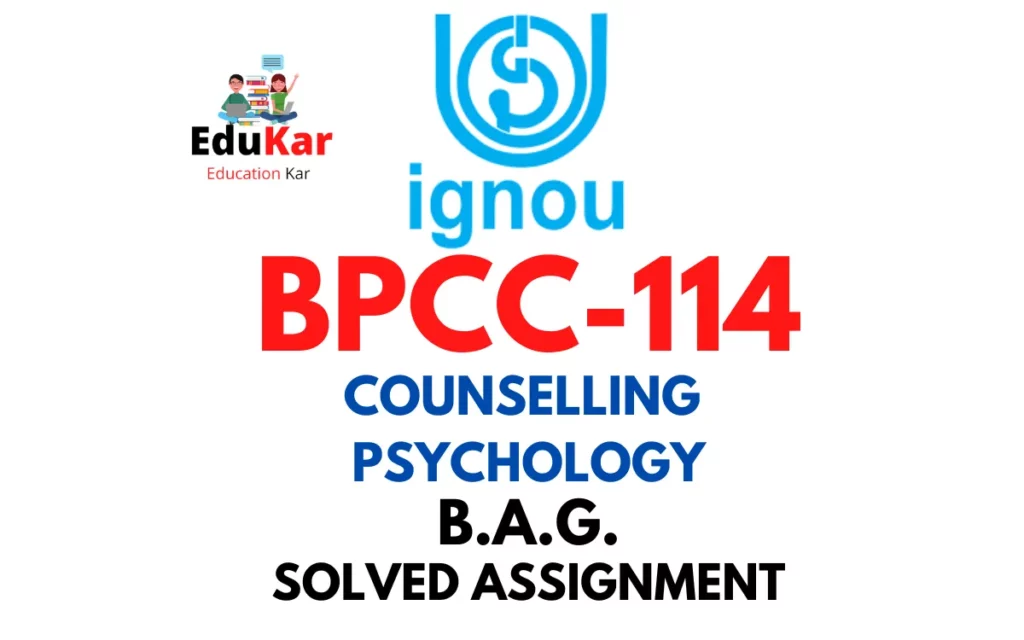Contents
- 1 Assignment I
- 2 Answer the following questions in about 500 words each. Each question carries 20 marks.
- 3 1. Describe relaxation techniques and Yoga as techniques of stress management.
- 4 2. Explain psychosomatic illnesses with a focus on Somatic Symptom and Related Disorder as given in DSM 5.
- 5 Assignment II
- 6 Answer the following questions in about 250 words each. Each question carries 10 marks.
- 7 3. Describe the effect of stress on health.
- 8 4. Explain acute and chronic pain.
- 9 5. Elucidate cognitive restructuring.
- 10 Assignment III
- 11 Answer the following questions in about 100 words each. Each question carries 6 marks.
- 12 6. Holistic model of health
- 13 7. Measurement of stress
- 14 8. Proactive and avoidant coping.
- 15 9. Acquired Immuno Deficiency Syndrome
- 16 10. Gainful employment
Welcome to Edukar.in! Get comprehensive and accurate solutions to the questions in IGNOU BPCG 173 course with our 2022-2023 solved assignment. Expertly prepared, in line with the latest syllabus and guidelines set by IGNOU. Achieve academic success with ease.
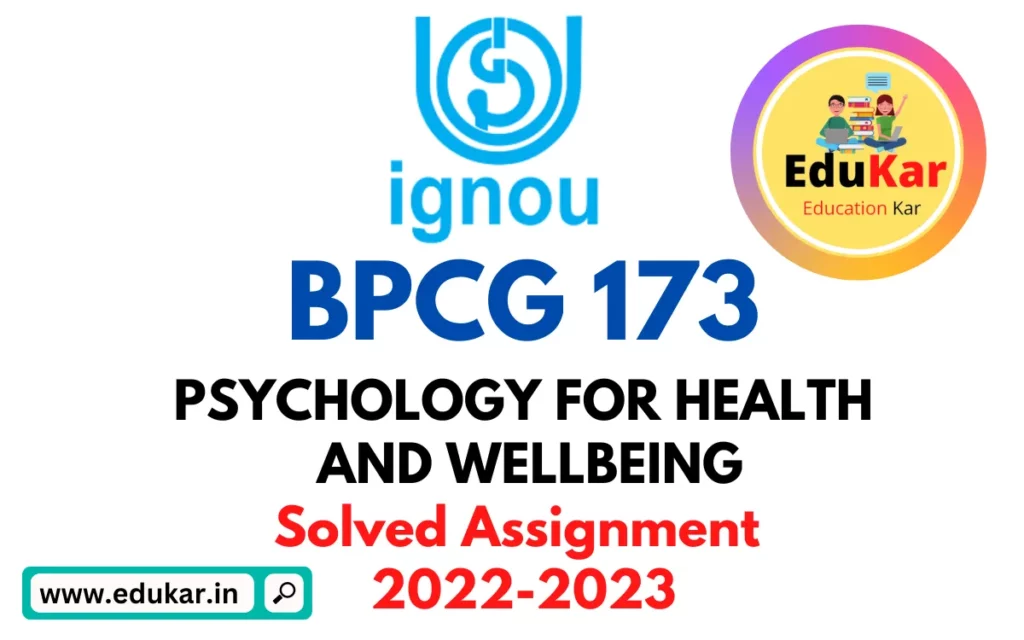
| Title | IGNOU-BPCG 173 Solved Assignment 2022-2023 (PSYCHOLOGY FOR HEALTH AND WELLBEING) |
| University | IGNOU |
| Degree | Bachelor Degree Programme |
| Course Code | BPCG-173 |
| Course Name | PSYCHOLOGY FOR HEALTH AND WELLBEING |
| Programme Name | Bachelor of Arts (General) |
| Programme Code | BAG |
| Total Marks | 100 |
| Year | 2022-2023 |
| Language | English |
| Assignment Code | BANS 183/ASST/TMA |
| Last Date for Submission of Assignment: | For June Examination: 31st March For December Examination: 30th September |
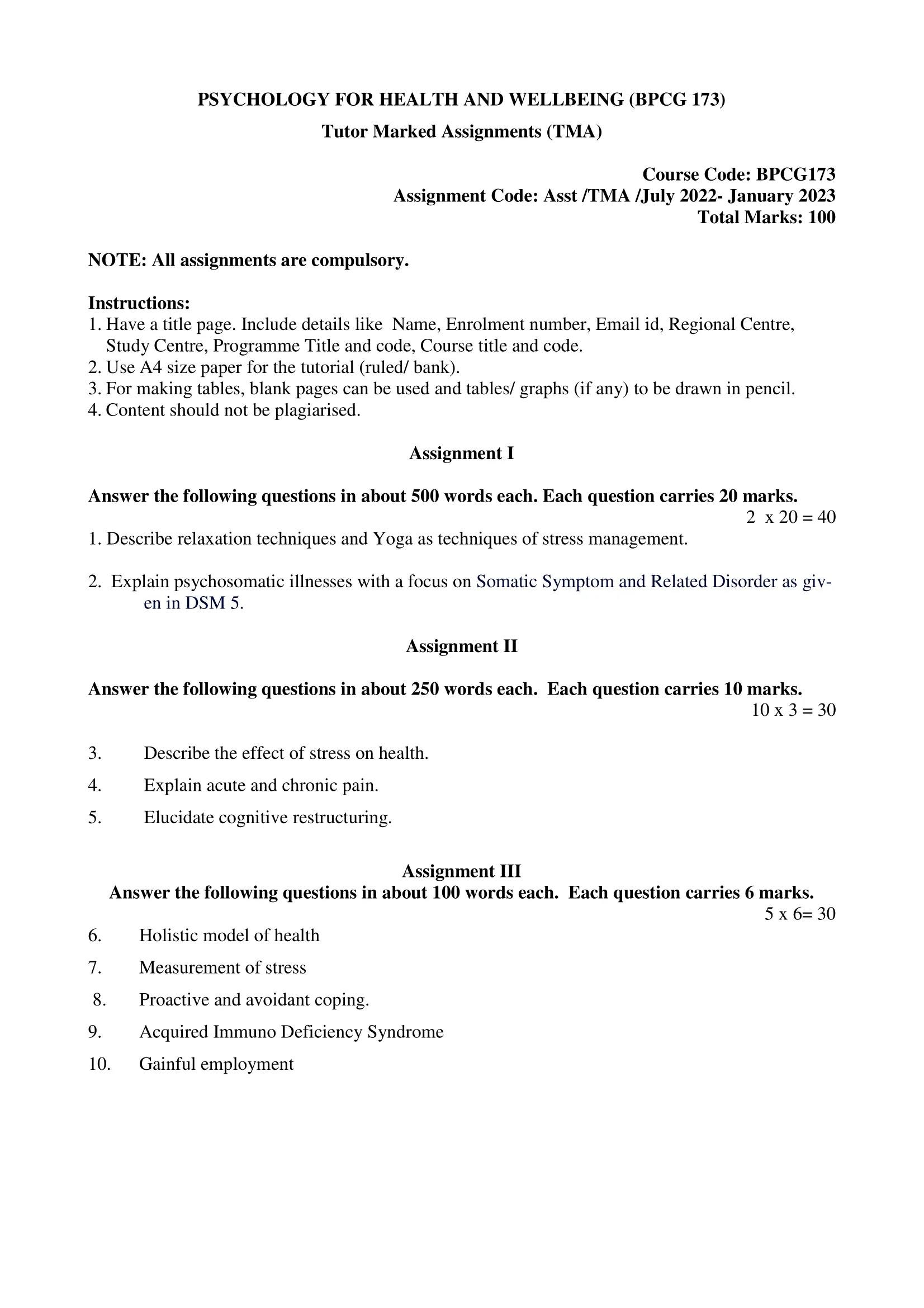
Assignment I
Answer the following questions in about 500 words each. Each question carries 20 marks.
1. Describe relaxation techniques and Yoga as techniques of stress management.
Ans: Relaxation techniques and Yoga are two effective methods for managing stress and improving overall well-being.
Relaxation techniques aim to calm the mind and body, reduce muscle tension and heart rate, and promote feelings of relaxation and peace. Some popular relaxation techniques include:
- Deep breathing: This involves taking slow, deep breaths and focusing on breathing out tension with each exhale.
- Progressive muscle relaxation: This involves tensing and then releasing different muscle groups to help release tension and improve relaxation.
- Meditation: This involves sitting in a quiet place, focusing on the breath, and clearing the mind of distractions and worries.
- Guided imagery: This involves using imagination and visualization to create a peaceful scene in the mind and relieve stress.
- Autogenic training: This involves repeating calming phrases and focusing on sensations in the body to promote relaxation.
Yoga, on the other hand, is a holistic practice that originated in ancient India and combines physical postures, breathing techniques, and meditation. Some benefits of practicing yoga include:
- Reduced muscle tension and improved flexibility: Yoga postures help stretch and strengthen muscles, releasing tension and promoting relaxation.
- Improved breathing: Yoga breathing techniques help to slow down breathing and promote deep, calming breaths.
- Reduced stress and anxiety: Yoga has been shown to lower levels of the stress hormone cortisol, reducing symptoms of stress and anxiety.
- Improved sleep: Regular yoga practice has been linked to improved sleep quality, making it easier to fall asleep and stay asleep.
- Increased mindfulness: Yoga encourages focus on the present moment, promoting mindfulness and reducing stress and worry.
Relaxation techniques and yoga offer a variety of methods for managing stress, improving physical and mental health, and promoting overall well-being. Incorporating these techniques into daily routine can help alleviate stress, reduce symptoms of anxiety and depression, and improve overall quality of life.
2. Explain psychosomatic illnesses with a focus on Somatic Symptom and Related Disorder as given in DSM 5.
Ans: Psychosomatic illness refers to a condition where physical symptoms are caused or worsened by psychological, emotional, or behavioral factors. This type of illness is a manifestation of the mind-body connection, where the thoughts and emotions of an individual can influence the functioning of their physical body. The fifth edition of the Diagnostic and Statistical Manual of Mental Disorders (DSM-5) classifies psychosomatic conditions under the category of Somatic Symptom and Related Disorders (SSRD).
Somatic Symptom and Related Disorders is a broad category that includes a range of conditions in which individuals experience physical symptoms that are distressing and cause significant disruption to their daily lives. This category includes conditions such as somatic symptom disorder, illness anxiety disorder, and conversion disorder.
Somatic Symptom Disorder (SSD) is a condition in which individuals experience persistent physical symptoms, such as pain, fatigue, or digestive problems, that are not fully explained by any medical condition. The symptoms cause significant distress and disruption to daily life, and individuals may become excessively preoccupied with their health and seek medical attention frequently.
Illness Anxiety Disorder (IAD), also known as hypochondria, is a condition in which individuals have an excessive and persistent fear of having a serious medical condition, despite evidence to the contrary. They often experience a range of physical symptoms, such as headaches, palpitations, and fatigue, and may undergo multiple medical evaluations without receiving a clear explanation for their symptoms.
Conversion Disorder, also known as functional neurological symptom disorder, is a condition in which individuals experience physical symptoms that cannot be explained by any underlying medical condition. These symptoms may include weakness, numbness, or loss of coordination, and are often triggered by psychological stress or conflict.
In order for an individual to receive a diagnosis of SSRD, their symptoms must cause significant distress or impairment in their daily life and cannot be fully explained by a medical condition, medication, or substance use. In addition, the symptoms must not be intentionally produced or feigned, as in the case of factitious disorder or malingering.
Treatment for SSRD typically involves a combination of psychotherapy and medication management. Psychotherapy, such as cognitive-behavioral therapy or psychodynamic therapy, can help individuals understand and manage their psychological and emotional factors that contribute to their symptoms. Medication, such as antidepressants, may be used to manage the physical symptoms of SSRD and reduce associated anxiety and depression.
Assignment II
Answer the following questions in about 250 words each. Each question carries 10 marks.
3. Describe the effect of stress on health.
Ans: Stress is a natural response of the body to challenging situations, but chronic stress can have serious effects on physical and mental health. Physiologically, stress triggers the release of cortisol and adrenaline, hormones that prepare the body to respond to perceived threats. In small amounts, these hormones can be beneficial, but prolonged exposure to stress hormones can damage the body in various ways.
For example, stress can weaken the immune system, making individuals more susceptible to illness and infection. Chronic stress can also increase the risk of developing heart disease, high blood pressure, and stroke. Furthermore, stress can disrupt the delicate balance of hormones in the body, leading to issues such as anxiety, depression, and sleep disturbances.
Stress can also lead to unhealthy coping mechanisms, such as overeating, smoking, and excessive drinking, which can cause further harm to the body. Additionally, stress can interfere with cognitive processes, making it difficult to concentrate, remember things, and make decisions.
Moreover, stress can cause physical symptoms such as headaches, muscle pain, and digestive problems. Furthermore, it can also exacerbate existing health conditions, such as asthma or diabetes.
4. Explain acute and chronic pain.
Ans: Pain is an unpleasant sensory and emotional experience that signals to the brain that something is wrong in the body. Pain can be classified into two main categories: acute and chronic.
Acute pain is a normal response to injury or tissue damage and usually goes away as the body heals. This type of pain is usually sharp, intense and occurs suddenly, and is usually a sign that the body is trying to protect itself. For example, if you burn your hand, you experience a sudden sharp pain as a response, and this pain will go away as the wound heals.
Chronic pain, on the other hand, persists for longer periods of time, often for more than three months. Chronic pain can be caused by a variety of factors, including injury, diseases, and nerve damage. This type of pain can be persistent, dull and sometimes difficult to describe, and it can interfere with daily activities, causing emotional distress, depression, and decreased quality of life.
Chronic pain can also have a profound impact on physical health, leading to muscle tension, sleep disturbances, and fatigue. Moreover, chronic pain can have a significant impact on mental health and well-being, leading to anxiety, depression and a decrease in overall quality of life.
5. Elucidate cognitive restructuring.
Ans: Cognitive restructuring is a therapeutic technique used in cognitive-behavioral therapy (CBT) to help individuals identify and change negative thought patterns that contribute to emotional distress. This technique involves identifying and challenging automatic thoughts that are irrational, exaggerated, or otherwise problematic, and replacing them with more balanced and adaptive thoughts.
The process of cognitive restructuring typically begins with the identification of negative thought patterns and how they affect emotions and behavior. For example, a person may have the automatic thought, “I’m a failure,” when faced with a setback at work. This thought can lead to feelings of disappointment, self-doubt, and decreased motivation.
In cognitive restructuring, the individual works with a therapist to analyze and challenge this thought. The therapist may ask the person to consider evidence that contradicts the thought and to think of alternative explanations for the setback. For example, the person may realize that the setback was due to factors outside of their control and that they have had many successes in the past.
The next step in cognitive restructuring is to replace the negative thought with a more balanced and adaptive one. In the previous example, the person may replace “I’m a failure” with “This setback is disappointing, but it doesn’t define me as a person. I have had many successes in the past, and I will continue to work towards my goals.”
Cognitive restructuring has been shown to be an effective technique for reducing symptoms of anxiety and depression, as well as improving overall quality of life. The process requires practice and effort, but over time, individuals can learn to identify and change negative thought patterns on their own. Cognitive restructuring can be done in individual therapy or in a group setting, and it can be a valuable tool for those seeking to improve their mental health and well-being.
Assignment III
Answer the following questions in about 100 words each. Each question carries 6 marks.
6. Holistic model of health
Ans: The holistic model of health recognizes that a person’s overall well-being is influenced by a combination of physical, emotional, spiritual, and social factors. This model approaches health and illness as a complete entity, rather than just focusing on individual symptoms or physical conditions. The holistic model considers the individual as a whole person, including their lifestyle, environment, relationships, and psychological state, in order to provide a comprehensive approach to healthcare. This model emphasizes the importance of considering the whole person, rather than just their physical symptoms, in order to understand and treat the root cause of an issue. The holistic model is gaining popularity as more people seek a more holistic and integrative approach to healthcare that addresses their overall well-being, rather than just treating individual symptoms.
7. Measurement of stress
Ans: Measurement of stress refers to the process of evaluating an individual’s level of stress and its impact on their physical, emotional, and cognitive well-being. There are various methods used to measure stress, including self-report questionnaires, physiological measures, and behavioral observations.
Self-report questionnaires, such as the Perceived Stress Scale (PSS), assess an individual’s subjective experience of stress and its impact on their life. Physiological measures, such as heart rate variability and cortisol levels, provide objective data on the body’s stress response. Behavioral observations, such as changes in sleep patterns and appetite, can also provide insight into stress levels.
It is important to use multiple methods of stress measurement to get a comprehensive understanding of an individual’s stress levels. This can help healthcare providers identify and address stress-related health problems and develop effective stress management strategies. Regular measurement of stress can also help individuals monitor their stress levels and track their progress in managing stress over time.
8. Proactive and avoidant coping.
Ans: Proactive and avoidant coping are two styles of coping with stress that individuals may use to deal with life challenges. Proactive coping involves taking active steps to address and solve problems, such as seeking support, problem-solving, and self-care. This type of coping helps individuals maintain control over their lives and promote well-being. On the other hand, avoidant coping involves avoiding or ignoring stressors, such as through denial, substance use, or escapism. This type of coping may provide temporary relief but can lead to more stress in the long term and can undermine mental health and well-being.
It is important for individuals to be aware of their coping styles and to find a balance between proactive and avoidant coping strategies. While some degree of avoidant coping may be necessary in certain situations, relying too heavily on avoidant coping can lead to negative consequences. In contrast, proactive coping can help individuals effectively manage stress and improve their overall well-being.
9. Acquired Immuno Deficiency Syndrome
Ans: Acquired Immuno Deficiency Syndrome (AIDS) is a chronic, potentially life-threatening condition caused by the human immunodeficiency virus (HIV). HIV attacks the immune system, leaving the body unable to fight off infections and diseases. AIDS is the most advanced stage of HIV infection and is characterized by a weakened immune system and a range of serious health problems. There is currently no cure for AIDS, but antiretroviral therapy (ART) can help manage the virus and slow the progression of the disease. It is important to get tested for HIV and to practice safe behaviors to prevent the spread of the virus. AIDS continues to be a global health crisis, and it is crucial to raise awareness, increase access to testing and treatment, and reduce stigma and discrimination associated with the disease.
10. Gainful employment
Ans: Gainful employment refers to a type of work that provides an individual with a sustainable income, benefits, and opportunities for advancement. This type of employment is often seen as a pathway to financial stability and independence. Gainful employment typically requires skills and training that are in demand in the job market, and it provides individuals with the opportunity to earn a living wage and improve their standard of living. Additionally, gainful employment may offer benefits such as health insurance, paid time off, and a retirement plan, which can contribute to financial security and well-being. Finding gainful employment is a key component of achieving financial stability, and it is an important goal for many individuals and families.
How to Download BPCG 173 Solved Assignment?
You can download it from the www.edukar.in, they have a big database for all the IGNOU solved assignments.
Is the BPCG 173 Solved Assignment Free?
Yes this is absolutely free to download the solved assignment from www.edukar.in
What is the last submission date for BPCG 173 Assignment?
For June Examination: 31st March, For December Examination: 30th September



![[Solved Assignment] BPCS 188-APPLICATIONS OF SOCIAL PSYCHOLOGY (IGNOU-BAG) 2022-2023 BPCS 188-APPLICATIONS OF SOCIAL PSYCHOLOGY IGNOU BAG Solved Assignment 2022-2023](https://edukar.in/wp-content/uploads/2023/01/BPCS-188-APPLICATIONS-OF-SOCIAL-PSYCHOLOGY-IGNOU-BAG-Solved-Assignment-2022-2023-1024x640.webp)


